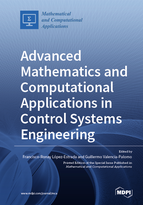Advanced Mathematics and Computational Applications in Control Systems Engineering
A special issue of Mathematical and Computational Applications (ISSN 2297-8747). This special issue belongs to the section "Engineering".
Deadline for manuscript submissions: closed (31 July 2020) | Viewed by 31906
Special Issue Editors
Interests: control applications; optimization; LMIs; Takagi–Sugeno; fault diagnosis
Special Issues, Collections and Topics in MDPI journals
Interests: predictive control; optimization; LPV systems; fault detection and isolation
Special Issues, Collections and Topics in MDPI journals
Special Issue Information
Dear Colleagues,
Control system engineering is a multidisciplinary discipline that applies automatic control theory to design systems with desired behaviors in control environments. Automatic control theory has played a vital role in the advancement of engineering and science. It has become an important and integral part of modern industrial and manufacturing processes. Today, the requirements for control precision have become higher, and real systems have become more complex, including higher order, discrete, hybrid, time-delayed linear, nonlinear systems, and systems without a mathematical model and uncertainties.
In control engineering, in parallel to all other engineering disciplines, the impact of advanced mathematical and computational methods is rapidly increasing. Advanced mathematical methods are needed because real-world control systems need to comply with several conditions related to product quality and safety constraints that have to be taken into account in problem formulation. Conversely, the increment in mathematical complexity has an impact on the computational aspects related with numerical simulation and practical implementation of the algorithms, where a balance must also be maintained between implementation costs and the performance of the control system.
The present Special Issue aims to present the recent advances in the development and application of advanced mathematics and computational applications in control system engineering. In addition to original research papers, review papers on the state-of-the-art and future perspectives are invited.
Potential topics include (but are not limited to):
- Linear and nonlinear systems;
- Complex systems;
- Observer design;
- Control systems;
- Fuzzy logic control systems;
- Neuronal network control systems;
- System identification;
- Takagi–Sugeno systems;
- LPV systems;
- Fault detection and isolation;
- Fault-tolerant control.
Dr. Francisco Ronay López-Estrada
Prof. Dr. Guillermo Valencia-Palomo
Guest Editors
Manuscript Submission Information
Manuscripts should be submitted online at www.mdpi.com by registering and logging in to this website. Once you are registered, click here to go to the submission form. Manuscripts can be submitted until the deadline. All submissions that pass pre-check are peer-reviewed. Accepted papers will be published continuously in the journal (as soon as accepted) and will be listed together on the special issue website. Research articles, review articles as well as short communications are invited. For planned papers, a title and short abstract (about 100 words) can be sent to the Editorial Office for announcement on this website.
Submitted manuscripts should not have been published previously, nor be under consideration for publication elsewhere (except conference proceedings papers). All manuscripts are thoroughly refereed through a single-blind peer-review process. A guide for authors and other relevant information for submission of manuscripts is available on the Instructions for Authors page. Mathematical and Computational Applications is an international peer-reviewed open access semimonthly journal published by MDPI.
Please visit the Instructions for Authors page before submitting a manuscript. The Article Processing Charge (APC) for publication in this open access journal is 1400 CHF (Swiss Francs). Submitted papers should be well formatted and use good English. Authors may use MDPI's English editing service prior to publication or during author revisions.
Keywords
- control systems
- control applications
- nonlinear control
- robust control
- real-time control implementations
- data-based control systems
- data-driven control systems







